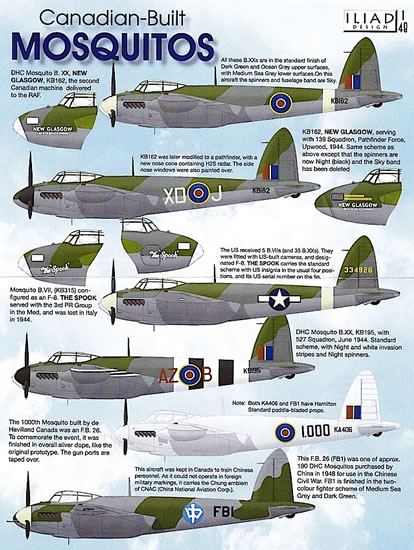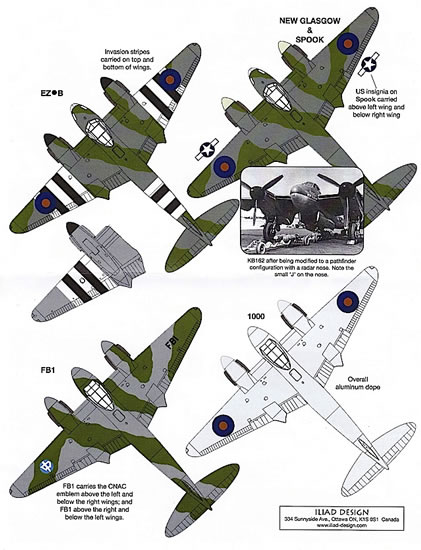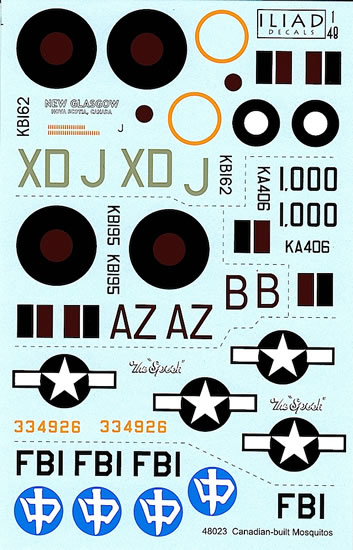Canadian-Built Mosquitos

Iliad Design,
1/48 scale
Catalogue Number and Description: |
Iliad Designs Item No. 48023 - Canadian-Built Mosquitos |
Scale: |
1/48 |
Contents and Media: |
1 x waterslide decal sheets of national markings, code letters and other aircraft-specific markings; 1 x A4 full-colour double-sided instruction sheet featuring six marking options for five aircraft |
Price: |
Available on-line from Iliad Design for Can$12.00 and these Iliad Design stockists may have the sheet in due course: Hannants and Squadron.
|
Review Type: |
First Look |
Advantages: |
Interesting subjects and high-quality decals |
Disadvantages: |
Instruction sheet appears to have some minor inaccuracies |
Conclusion: |
Highly recommended to anyone with an interest in the Mosquito, and/or who wants a model that is a little bit different. |
Reviewed by Brad Fallen

HyperScale is proudly supported by Squadron.com
Iliad Design is an Ottawa, Canada based company that produces 1/48 and 1/72 aircraft decals, as well as paint colour charts and books. Iliad specialises in subjects that are slightly offbeat – previous decal releases include ‘Sub-Hunting Liberators’, ‘Strange Hurricanes’ and ‘Camouflaged B-29s’. Now, for what I think is the first time, Iliad has turned its attention to a Canadian subject – some of the 1,065 Mosquitos built by de Havilland Canada near Toronto between 1942 and 1945. While at first glance the aircraft featured on this sheet appear to be somewhat plain, a little research reveals that Iliad has remained true to its spirit of focusing on the different and the unusual.

The featured aircraft are:
-
Mosquito B.XX, KB162, “New Glasgow”. Markings are provided for KB162 in both its original delivery scheme (it was the second Canadian-built Mosquito to be delivered to the RAF), and during its service with 139 Squadron, Pathfinder Force, RAF Upwood, 1944, following its conversion to a pathfinder aircraft. Both versions feature the same Dark Green and Ocean Grey over Medium Sea Grey finish and “New Glasgow” nose art, but the delivery scheme has Sky spinners and fuselage band, no code letters and a glazed nose cone, while the pathfinder scheme has black spinners, no fuselage band, code letters (XD-J), a solid nose (for housing the H2S radar unit), and an impressive mission tally. The one photo that I have been able to find of KB162 – in its original guise – matches the marking information provided by Iliad.
-
Mosquito B.VII/F-8, KB315, “The Spook”, 3rd Photographic Reconnaissance Group, USAAF, Italy, 1944. Built as a B.VII, KB315 was one of the first Canadian-built Mosquitos transferred to the USAAF, which converted the aircraft to a photo-reconnaissance platform and deployed it to the Mediterranean. KB135 was finished in standard Dark Green/Ocean Grey/Medium Sea Grey, with Sky spinners and fuselage band. There are some minor discrepancies between Iliad’s marking guide and a number of photos I have found of KB315, with the photos featuring shrouded exhausts and fuselage stars-and-bars which are closer to the fuselage band. However, it is possible that these photos represent KB315 at an earlier stage in its career (in one of the images, the aircraft was still in its original RAF markings), while Iliad has depicted it whilst on operations in Italy. Whatever the reason, if you are planning on building “The Spook” I recommend you check your references carefully.
-
Mosquito B.XX, KB195/AZ-B, RAF, June 1944. While listed by Iliad as belonging to 527 Squadron, this is likely a typographic error, as 527 Squadron was at the time a radar calibration unit flying Hurricanes, while 627 Squadron was a pathfinder unit flying Mosquitos with ‘AZ’ squadron codes. Quibbles aside, KB195 is a great looking aircraft, with its standard Dark Green/Ocean Grey/Medium Sea Grey camouflage set off by red squadron codes and a full set of invasion stripes. The spinners were black. While I have been unable to find any images of KB195, photos of other 627 Squadron B.XXs from the same period suggest that Iliad’s marking guide is correct.
-
Mosquito FB.26, KA406. The 1,000th Mosquito built by de Havilland Canada, KA406 was finished in silver dope and featured a large black ‘1,000’ painted on both sides of the fuselage between the roundel and serial number. KA406 was a very well photographed machine, so if you are considering modeling this aircraft, you will have plenty of references.
-
Mosquito FB.26, FB1. This aircraft was one of 250 surplus Canadian-built Mosquitos purchased by the Chinese Nationalist Government after the end of the war. Most were exported to Shanghai, where approximately 190 were assembled and test flown, with the rest abandoned to advancing Communist forces. Nine, including FB1, were retained in Toronto for training purposes. Finished in the two-colour scheme of Dark Green and Medium Sea Grey, FB1 carried the striking blue and white marking of the China National Aviation Corporation, which will be bound to make any model finished in this scheme stand out from the rest!
The decals appear to be of good quality – they are crisply printed and the colour interpretations seem reasonable, including the red of the RAF markings which is nicely subdued. I used some of the decals from Iliad’s 1/48 Dewoitine D.520 sheet in a recent project and they performed very well, being thin, flexible, and settling down without any silvering; I see no reason why these decals should be any different.

No stencils are provided, but these can be readily sourced from elsewhere – Barracudacals in particular produces a very nice sheet of 1/48 Mosquito stencils.
This is a very interesting and well-produced decal sheet. Iliad’s choice of subject matter is excellent, and encourages further research – despite owning a number of reference books on the Mosquito, I knew very little about its production in Canada until I started writing this review. Although I have questioned the accuracy of a couple of points in the instruction sheet, these are only minor complaints. All in all this is a great package that can be highly recommended to anyone with an interest in the Mosquito, and/or who wants to finish a model that looks a little bit different.
References
Stuart Howe, de Havilland Mosquito: An Illustrated History, Volume 1, Crecy Publishing, 1999.
Ian Thirsk, de Havilland Mosquito: An Illustrated History, Volume 2, Crecy Publishing, 2006.
Richard A. Franks, The de Havilland Mosquito: A Comprehensive Guide for the Modeller, SAM Publications, 1998.
Thanks to Iliad Design for this sample.
Text and Images Copyright © 2012 by Brad Fallen
This Page Created on 2 May, 2012
Last updated
3 May, 2012
Back to
HyperScale Main Page

|
